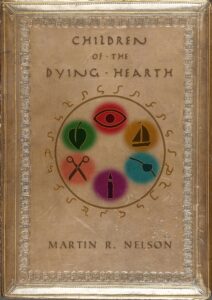Pondering history, myth, and fantasy from an early age, Martin grew up in Southern Oregon wondering what lay outside the sleepy Pacific Northwest. Readings of haunted lighthouses and native legends quickly turned to readings of the Kalevala and Prose Edda. He took his interests to school where he graduated from University of Portland with a BA in History with a focus on Pagan and Christian interactions in Late Antiquity, then to Fordham University where he earned an MA in History with a focus on royal saints in High Medieval Scandinavia. He now teaches Medieval History and Latin, residing with his fiancé and their two cats, Apollo and Cupid, back where it all began in Southern Oregon.
Fiction
Novels
The Annals of Tessian, Book 1
Children of the Dying Hearth

When the world was young, there were the Ancients: primordial beings who shaped the land and bore all life. From the most powerful Ancient came the Imperial Dynasty of Kai’loth, tasked by their creator to govern the realms of Tesseris. For countless generations they ruled justly and peacefully.
Then they defied Him.
Thousands of years after their Sundering, the empire’s story is barely remembered as a legend. The lands of Tesseris are now united only by the Crux, a city-state whose corruption is publicly known and secretly reviled. Yet the Crux’s rulers have their own problems. Pirates plague the Verdant Sea, unleashing terror and chaos in their wake. Meanwhile the ancient sands of the Barrens begin to stir, a sign of something far more ancient…and deadly…than any pirate.
Yet some see the chaos and corruption as a chance. Whispers spread of a lost heir to the old empire. A select few seek to help a young hopeful whose bloodline could alter the world, but others hope death, not destiny, will find the child first.
The Annals of Tessian, Book 2:
Coming Soon!
Short stories
“THE JOURNAL OF DR. RUDY J. GLEEMEN”

Written after a lengthy Lovecraft binge, this short story received Honorable Mention in 2016’s L. Ron Hubbard’s Writers of the Future Contest. It’s very much an exercise in consequentialism that was originally intended as a full length novel, which it may end up being one of these days.
Academic Research
Research
“By Their Own Will: Agency and Authorial Intent in Seneca and Saint Perpetua’s Voluntary Deaths.”
Written as a capstone project to a theology course in my final semester of my MA program at Fordham University. This essay examines how human will was interpreted within the martyrdom narratives of the early Christian world, with particular emphasis on how taking one’s own life was promoted through that will.
“‘Such a Splendor of Brightness’: The Establishment of Ringsted in Liturgical Texts as the Site of Knud Lavard’s Cult.“
Written and given as my Master’s Thesis at Fordham University in 2017, this paper explores two religious narratives to answer Duke Knud Lavard, the second Danish royal saint, was buried at the relatively inconsequential church in Ringsted. First, the offices and masses commissioned by Valdemar I in 1170 in Kiel University Library’s MS S.H. 8 A.8∞, which emphasizes locality in its music and words; and second, the miracles compiled by Robert of Ely in 1135 which survive in the Arnamagnaean Institute’s AM 1049 4° and shows the saint himself designated Ringsted’s importance.
Latin Translations
I have professionally translated sources for work as a graduate student and as a teacher. I currently offer a upper division Latin class at my school which aims to guide high school Latin scholars into past writings through professional translations in conjunction with Fordham University’s Internet History Sourcebook.
The Fable of the Monk and the Bird
Kiel University’s S.H. 8 A.8∞ is a manuscript largely devoted to the liturgical services (called the offices and masses) of St. Knud (Canute) Lavard, Denmark’s patron saint. Knud was a 12th century prince of Denmark who, according to the text, died a martyr’s death in 1131 when his own cousin, Magnus, betrayed and killed him. The liturgy is divided into two main sections: Knud’s Passion and his Translation. These sections contain lectiones (readings) on the life and death of Knud, along with music (hymns, psalms, and antiphons) dedicated to the saint. While Knud’s Passion deals with events before his death, the Translation is primarily concerned with moving his body to Ringsted to be interred, later political events, and the canonization of Knud Lavard.
Following the liturgy is a short section taken from the Chronicon Roskildense, followed by the brief didactic fable below; both the Chronicon and the fable were penned by one hand. The fable exists only in this manuscript but could have originated in Ireland since it shares a motif common to the lives of early Irish saints: a distracted monk is led away by heavenly birdsong. One scholar of the text, Michael Chesnutt, has suggested that the story’s style denotes an oral delivery, and was therefore meant to be read in front of a group of monks, perhaps at their evening meal.
A Medieval Bestiary
Medieval bestiaries describe the appearance and behaviors of real and legendary animals but also communicate Christian meanings and moral lessons through allegory. The manuscripts often include illustrations and draw particularly on a Greek text called the Physiologus, as well as other ancient Greek and early medieval authors.
British Library Additional Manuscript 11283, dated to c. 1180 in Chester (England), is the earliest extant manuscript of a Second Family Bestiary, which consists of three major parts. The first (f. 1r-32r) is separated broadly into entries on various “animals”, “reptiles”, and “fish”; the second covers different trees (32r-34r); and the third centers on the “Nature of Man” (34r-41r). It sometimes differs, however, in formatting and contents. Unlike other Second Family bestiaries, for example, it places Adam’s naming of the animals not at the beginning but after several animals have already been described. The order of animals is mostly consistent with Second Family bestiaries but with some differences: for instance, the section on trees is largely absent from Add. MS. 11283.
The texts on individual animals are not consistent; thus the entry on dogs in Add. Ms. (9v-11v) contains four subsections on four folios, while the entry on horses is only one section spanning four folios (13v-15r). These subsections are formatted with capitals identical to new entries. Like most medieval bestiaries, Add. MS. 11283 records several mythical animals, including humanoids such as the satyr and siren. The siren, curiously, appears in the middle of the bird section. Since this cites Physiologus, its placement may perhaps be a remnant of pre-Christian iconography that depicted sirens as half bird rather than half fish. Additionally, there are no titles for any sections, and therefore titles have been inserted in the appropriate section breaks to demarcate both animals from each other and subsections within animal groups.
The illustrations are simple yet detailed enough to match the physical characteristics or descriptions of the behavior of individual animals and were clearly drawn from examples in other bestiaries. Color is used in alternating blue and red capitals to denote sections, but most illustrations are done in brown ink. Color is, however, used for the Phoenix, Tiger, shading of the Lion (which is curiously green), Cinnamon Bird (which matches the Phoenix), Peacock, Rooster, and the final folio (41r) depicting a lake of fire.
The manuscript contains multiple marginal notes that mainly signal information taken from Polyhistor written in the third century by the Roman geographer and grammarian, Gaius Julius Solinus. This work, originally titled both De Mirabilibus Mundi (On the Marvels of the World) and Collectanea Rerum Memorabilium (Collection of Remarkable Things) before being given the title Polyhistor (Many-Stories), achieved “unrivaled popularity in the Middle Ages” according to historian G.H.T. Kimble. Whether for popularity, brevity, preference, or availability, the author of this MS has frequently cited Polyhistor, and seems to derive much of the non-Biblical sections from this compilation of curiosities.
